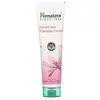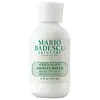What's inside
What's inside
 Key Ingredients
Key Ingredients

 Benefits
Benefits

 Concerns
Concerns

 Ingredients Side-by-side
Ingredients Side-by-side

Water
Skin ConditioningStearic Acid
CleansingEthylhexyl Methoxycinnamate
UV AbsorberGlycerin
HumectantIsopropyl Myristate
EmollientNiacinamide
SmoothingParfum
MaskingPotassium Hydroxide
BufferingPhenoxyethanol
PreservativeMethylisothiazolinone
PreservativeCetyl Alcohol
EmollientCoco-Caprylate/Caprate
EmollientButyl Methoxydibenzoylmethane
UV AbsorberCrocus Sativus Flower Extract
MaskingCaprylic/Capric/Stearic Triglyceride
Skin ConditioningAcrylates/C10-30 Alkyl Acrylate Crosspolymer
Emulsion StabilisingDisodium EDTA
Tocopheryl Acetate
AntioxidantMedicago Sativa Extract
TonicCI 47005
Cosmetic ColorantWater, Stearic Acid, Ethylhexyl Methoxycinnamate, Glycerin, Isopropyl Myristate, Niacinamide, Parfum, Potassium Hydroxide, Phenoxyethanol, Methylisothiazolinone, Cetyl Alcohol, Coco-Caprylate/Caprate, Butyl Methoxydibenzoylmethane, Crocus Sativus Flower Extract, Caprylic/Capric/Stearic Triglyceride, Acrylates/C10-30 Alkyl Acrylate Crosspolymer, Disodium EDTA, Tocopheryl Acetate, Medicago Sativa Extract, CI 47005
Butyl Methoxydibenzoylmethane 2%
UV AbsorberEthylhexyl Methoxycinnamate 7.5%
UV AbsorberBenzophenone-3 5%
UV AbsorberWater
Skin ConditioningHydrogenated Polyisobutene
EmollientGossypium Herbaceum Seed Oil
Skin ConditioningEthylhexyl Methoxycrylene
Skin ConditioningStearic Acid
CleansingCetyl Alcohol
EmollientSoluble Collagen
HumectantGlyceryl Stearate
EmollientPEG-100 Stearate
Acrylates/C10-30 Alkyl Acrylate Crosspolymer
Emulsion StabilisingSodium Hydroxide
BufferingLeuconostoc/Radish Root Ferment Filtrate
AntimicrobialPhenoxyethanol
PreservativeCaprylyl Glycol
EmollientHexylene Glycol
EmulsifyingButyl Methoxydibenzoylmethane 2%, Ethylhexyl Methoxycinnamate 7.5%, Benzophenone-3 5%, Water, Hydrogenated Polyisobutene, Gossypium Herbaceum Seed Oil, Ethylhexyl Methoxycrylene, Stearic Acid, Cetyl Alcohol, Soluble Collagen, Glyceryl Stearate, PEG-100 Stearate, Acrylates/C10-30 Alkyl Acrylate Crosspolymer, Sodium Hydroxide, Leuconostoc/Radish Root Ferment Filtrate, Phenoxyethanol, Caprylyl Glycol, Hexylene Glycol
Ingredients Explained
These ingredients are found in both products.
Ingredients higher up in an ingredient list are typically present in a larger amount.
Acrylates/C10-30 Alkyl Acrylate Crosspolymer is a synthetic polymer. It is used to thicken and improve the texture of products. Due to its properties, it can prevent water and oil ingredients from separating.
Also known as Avobenzone, this ingredient is a chemical sunscreen filter that provides protection in the UV-A range.
Avobenzone is globally approved and is the most commonly used UV-A filter in the world.
Studies have found that avobenzone becomes ineffective when exposed to UV light (it is not photostable; meaning that it breaks down in sunlight). Because of this, formulations that include avobenzone will usually contain stabilizers such as octocrylene.
However, some modern formulations (looking at you, EU!) are able to stabilize avobenzone by coating the molecules.
Avobenzone does not protect against the UV-B range, so it's important to check that the sunscreen you're using contains other UV filters that do!
The highest concentration of avobenzone permitted is 3% in the US, and 5% in the EU.
Learn more about Butyl MethoxydibenzoylmethaneCetyl Alcohol is a fatty alcohol. Fatty Alcohols are most often used as an emollient or to thicken a product.
Its main roles are:
Though it has "alcohol" in the name, it is not related to denatured alcohol or ethyl alcohol.
The FDA allows products labeled "alcohol-free" to have fatty alcohols.
Learn more about Cetyl AlcoholEthylhexyl Methoxycinnamate is an organic compound that provides UVB protection. It often goes by the more common name of octinoxate. It is created from methoxycinnamic acid and 2-ethylhexanol.
Ethylhexyl Methoxycinnamate absorbs UVB rays with wavelengths between 280-320 nm. UV absorbers protect your skin by using chemical reactions to convert UV rays into heat and energy.
UVB (290-320 nm) rays emit more energy than UVA rays. They are capable of damaging DNA, causing sunburns and are thought to be linked to skin cancer.
The state of Hawaii has banned sunscreens containing octinoxate due to its potential impact on coral reefs. More research is needed to bridge gaps in this research. The European Union allows higher levels of octinoxate in sunscreens than the US and Australia.
Ethylhexyl Methoxycinnamate is oil soluble. It is not stable and may lose efficacy when exposed to sunlight.
Learn more about Ethylhexyl MethoxycinnamatePhenoxyethanol is a preservative that has germicide, antimicrobial, and aromatic properties. Studies show that phenoxyethanol can prevent microbial growth. By itself, it has a scent that is similar to that of a rose.
It's often used in formulations along with Caprylyl Glycol to preserve the shelf life of products.
Stearic Acid is a fatty acid. It is an emollient, emulsifier, and texture enhancer.
As an emollient, stearic acid helps soften skin. It aids the skin's protective barrier by preventing water loss. It also provides a gentle cleansing effect without stripping away natural oils.
Stearic acid may also be used to enhance the texture of products. It can add volume and stabilize ingredients such as water and oil. This can help water and oil ingredients from separating.
Sources of stearic acid include animal or vegetable fats/oils such as coconut or shea. It can be naturally found in butter, cocoa butter, shea butter, vegetable fats, and animal tallow.
This ingredient may not be Malassezia folliculitis, or fungal-acne safe.
Learn more about Stearic AcidWater. It's the most common cosmetic ingredient of all. You'll usually see it at the top of ingredient lists, meaning that it makes up the largest part of the product.
So why is it so popular? Water most often acts as a solvent - this means that it helps dissolve other ingredients into the formulation.
You'll also recognize water as that liquid we all need to stay alive. If you see this, drink a glass of water. Stay hydrated!
Learn more about Water